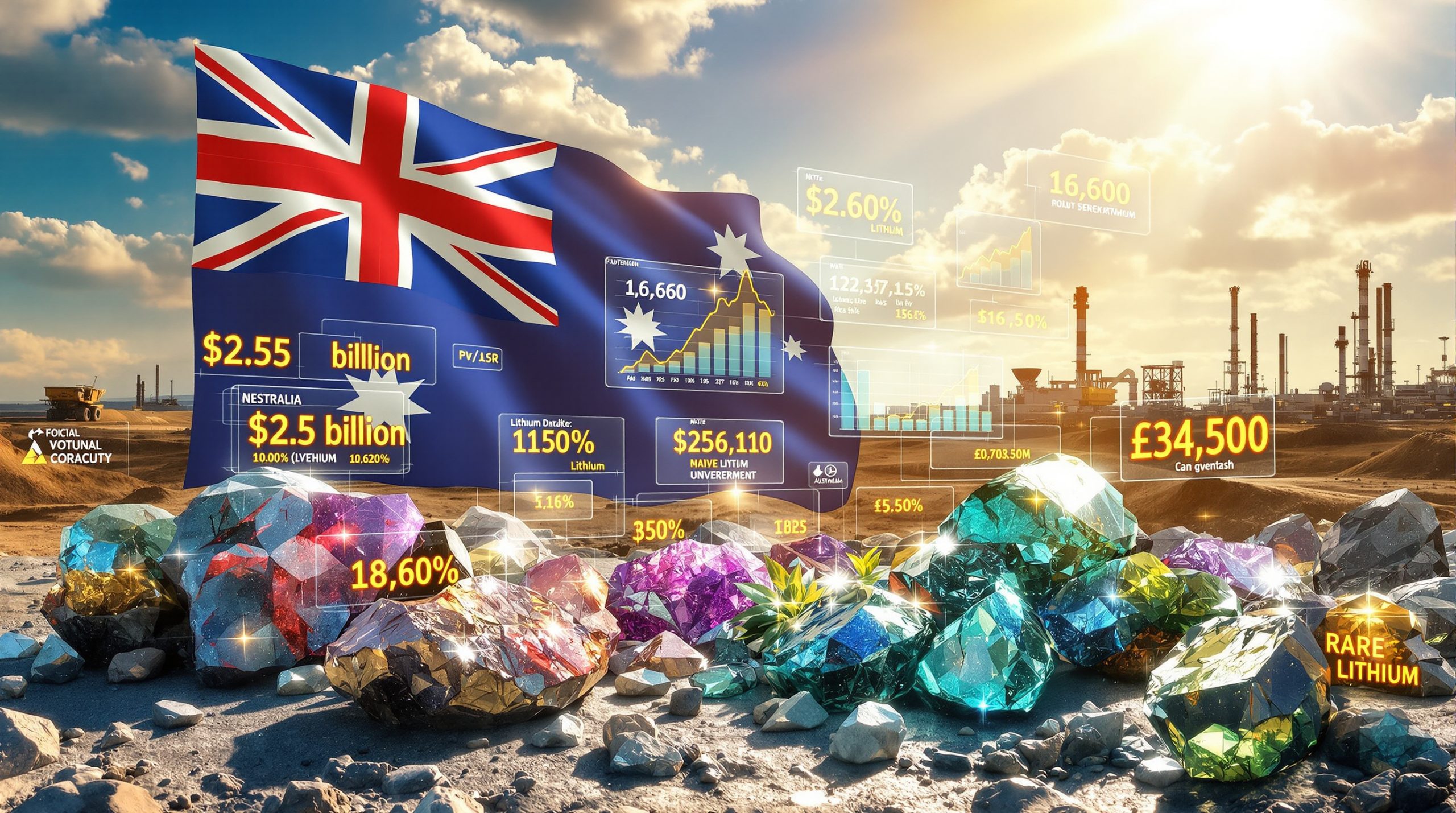What Are ASX 200 Materials Shares?
The materials sector on the Australian Securities Exchange (ASX) represents companies involved in the discovery, development, and processing of raw materials. This sector forms one of the 11 distinct market segments on the ASX 200 and plays a pivotal role in Australia's resource-driven economy.
Understanding the Materials Sector
Materials companies span the full spectrum of resource extraction, processing, and product development. These businesses operate across diverse subsectors including mining operations, metal fabrication, chemical production, and construction materials manufacturing.
Australia's rich geological endowment has created a particularly robust materials sector, with world-class deposits of iron ore, gold, copper, bauxite, and increasingly important battery metals like lithium and nickel. The sector's prominence reflects Australia's position as one of the world's leading resource economies.
Key Components of the ASX 200 Materials Sector
The materials sector encompasses several distinct business categories:
- Mining companies: Extraction-focused businesses targeting iron ore, gold, copper, lithium, and other minerals
- Steel producers and metal fabricators: Companies that refine and process raw materials into industrial metals
- Industrial gas and chemical manufacturers: Businesses producing specialty chemicals and industrial gases
- Construction materials suppliers: Companies providing cement, concrete, and other building materials
- Packaging and container producers: Manufacturers of paper, plastic, and other packaging solutions
Why Are Materials Shares Important to Australian Investors?
Materials shares represent a cornerstone investment opportunity within the Australian market, offering exposure to both domestic economic strength and global commodity cycles.
Economic Significance
The materials sector constitutes approximately 20% of the ASX 200 index by market capitalization, making it one of the most influential sectors in the Australian market. This substantial weighting means that major mining companies like BHP, Rio Tinto, and Fortescue often drive broader market movements.
The sector's performance frequently serves as a barometer for Australia's overall economic health, given the country's reliance on resource exports. When materials shares perform strongly, this typically signals robust global demand for Australian resources.
Global Demand Indicators
Materials companies function as real-time indicators of global economic activity and commodity demand. Their performance often provides investors with insights into:
- Construction and infrastructure development trends in major economies
- Manufacturing activity levels worldwide
- Inventory cycles across industrial supply chains
- Early signals of economic expansion or contraction
Chinese economic activity in particular drives demand for Australian resources, with iron ore demand trends representing Australia's largest single commodity export. When Chinese construction and steel production increase, Australian materials shares typically benefit from higher commodity prices and export volumes.
Dividend Potential
Many established materials companies offer attractive dividend yields, particularly during commodity price upswings. The major miners have historically provided significant income returns when commodity prices are elevated, making them popular among income-focused investors.
During the 2020-2022 iron ore price boom, for instance, companies like Fortescue delivered dividend yields exceeding 10%, significantly outpacing the broader market average. Even during more normalized market conditions, the sector often provides above-average income potential.
How Have ASX 200 Materials Shares Performed Recently?
Materials shares have demonstrated exceptional momentum in recent trading sessions, outperforming the broader market by a substantial margin.
Recent Sector Performance
The materials sector has shown remarkable strength with consecutive weeks of substantial gains:
- 3.65% sector growth in the most recent trading week
- 5.24% growth in the previous week
- Cumulative growth of approximately 8.89% over a two-week period
This consistent upward trajectory indicates strong investor confidence in resource companies amid favorable commodity price movements and demand signals.
Comparison to Overall Market
While the broader ASX 200 has performed admirably, reaching new record highs with a 1.49% weekly gain to close at 8,938.6 points, materials shares have significantly outpaced the index. The sector's outperformance highlights its current market leadership role and the strength of underlying commodity prices.
This leadership position is particularly notable given the diverse performance across other sectors, with ten of the eleven market sectors finishing positive, but none matching materials' robust gains.
Key Performance Drivers
Several fundamental factors have contributed to the materials sector's strong performance:
- Iron ore price strength: The benchmark iron ore price has traded above US$100 per tonne since August 4, representing a 5.5% increase over the past month
- Chinese demand signals: Fresh indicators of robust demand from China, including stronger-than-expected industrial production data
- Positive investor sentiment: Broader market optimism following interest rate cuts in major economies
- Employment data: Favorable jobs reports supporting expectations for continued economic growth
- Production discipline: Major miners maintaining supply restraint, supporting commodity price stability
Which Major Iron Ore Miners Dominate the Materials Sector?
Iron ore producers represent the largest component of the ASX materials sector by market capitalization, with three major players dominating the landscape.
BHP Group Ltd (ASX: BHP)
BHP, Australia's largest mining company and a global resources leader, has demonstrated impressive resilience with a 4.35% weekly share price increase to finish at $41.96. This performance comes as investors position themselves ahead of BHP's upcoming financial results.
The company's diversified portfolio spanning iron ore, copper, metallurgical coal, and petroleum provides operational stability across commodity cycles. BHP's low-cost production profile, particularly at its Western Australian iron ore operations, ensures strong profit margins even during periods of price volatility.
Fortescue Ltd (ASX: FMG)
Fortescue shares have showcased exceptional momentum with a 5.25% weekly gain, pushing the share price to $19.84. This performance extends a remarkable run that has delivered nearly 20% share price appreciation in just one month.
As a pure-play iron ore producer, Fortescue benefits directly from strengthening iron ore price forecast. The company's aggressive cost management initiatives and expansion into green hydrogen and metals present additional growth avenues beyond its core iron ore business.
Rio Tinto Ltd (ASX: RIO)
Rio Tinto shares increased by 1.26% to reach $115.05, showing more modest but still positive performance. As one of the world's largest diversified miners, Rio continues to benefit from strong iron ore prices while also maintaining significant exposure to aluminum, copper, and other industrial metals.
The company's world-class iron ore operations in the Pilbara region of Western Australia provide consistent cash flow, while its global portfolio offers geographical diversification and exposure to multiple commodity cycles.
How Are Gold Mining Shares Performing in the Current Market?
Gold mining shares have maintained positive momentum, offering investors exposure to precious metals alongside the sector's industrial commodities.
Gold Sector Overview
The S&P/ASX All Ordinaries Gold Index (ASX: XGD) outperformed the broader market with a 1.84% weekly gain. This resilient performance reflects both stable gold prices and operational improvements across the sector.
Gold producers benefit from their counter-cyclical characteristics, often performing well during periods of economic uncertainty or inflation concerns. The precious metal's historical role as a store of value continues to attract investment during periods of market volatility.
Northern Star Resources Ltd (ASX: NST)
Northern Star shares increased by 1.33% to reach $18.32 as investors anticipate the company's upcoming financial results. As one of Australia's premier gold producers, Northern Star has built an impressive portfolio of high-quality assets across Western Australia and North America.
The company's disciplined acquisition strategy and focus on high-grade, long-life operations has established it as a preferred exposure in the gold mining space. Northern Star's operational diversification across multiple mining centers provides production stability and exploration upside.
Evolution Mining Ltd (ASX: EVN)
Evolution Mining demonstrated particularly strong performance with a 4.57% weekly gain, pushing shares to $8.01. The company's operational improvements and cost management strategies have resonated positively with investors seeking quality gold exposure.
Evolution's portfolio optimization efforts, focusing on higher-margin operations while divesting non-core assets, has strengthened its production profile and reduced all-in sustaining costs. This disciplined approach has enhanced free cash flow generation and dividend sustainability.
Newmont Corporation CDI (ASX: NEM)
Newmont shares experienced a slight 0.54% decline to $106.10, underperforming other gold miners. As the world's largest gold producer following its merger with Goldcorp, Newmont's performance is closely watched as an indicator for the broader gold mining industry.
The company's global operational footprint provides unmatched scale and diversification, though integration challenges and cost pressures have created near-term headwinds for the share price. Nevertheless, many analysts remain optimistic about the gold price highs analysis and its impact on producers.
What Other Materials Companies Are Worth Watching?
Beyond mining giants, the ASX materials sector features several notable companies across construction materials, steel production, chemicals, and packaging.
Building Materials and Construction
James Hardie Industries plc (ASX: JHX) delivered exceptional performance with a 6.29% weekly gain to $45.60, outpacing many mining companies. As a global leader in fiber cement products, James Hardie benefits from construction activity across multiple markets, particularly residential housing in North America.
The company's innovative product development and premium brand positioning have enabled it to maintain pricing power and margin strength despite periodic housing market fluctuations. James Hardie's expansion into new product categories and geographical markets provides multiple growth avenues.
Steel Production
BlueScope Steel Ltd (ASX: BSL) shares rose 2.15% to $24.24, reflecting positive sentiment toward steel producers despite ongoing global supply chain challenges and input cost pressures.
BlueScope's vertical integration and strong positions in the Australian, North American, and Asian markets provide operational diversity and exposure to different construction and manufacturing cycles. The company's focus on value-added products has helped insulate margins from commodity steel price volatility.
Industrial Chemicals and Explosives
Orica Ltd (ASX: ORI) shares increased by 1.02% to finish at a 5-year high of $21.88. As a leading provider of commercial explosives and blasting systems to the mining industry, Orica's performance often correlates with mining industry innovation and activity levels.
The company's technological innovation in digital blasting solutions and focus on customer-specific applications has strengthened its competitive position. Orica's global operational footprint ensures exposure to mining activity across multiple regions and commodities.
Packaging Solutions
Amcor CDI (ASX: AMC) was the notable underperformer in the materials sector, dropping 7.73% to $13.60 following financial results that fell short of analyst expectations. Despite reporting a 43% increase in EBITDA to US$789 million, the results disappointed market participants who anticipated stronger outcomes.
The selloff pushed shares to a 52-week intraday low of $13.21 on Friday, highlighting the market's sensitivity to earnings disappointments even amid sector strength. Amcor's focus on sustainable packaging solutions and global scale position it for long-term growth despite near-term challenges.
How Do Materials Shares Compare to Other ASX 200 Sectors?
The materials sector has established itself as the clear market leader in recent trading sessions, outpacing all other ASX sectors.
Sector Performance Comparison
According to S&P/ASX 200 Materials Sector data, here's how all eleven ASX sectors performed in the most recent trading week:
- Materials (ASX: XMJ): +3.65%
- Consumer Staples (ASX: XSJ): +2.45%
- Healthcare (ASX: XHJ): +2.41%
- Utilities (ASX: XUJ): +1.48%
- A-REIT (ASX: XPJ): +1.09%
- Communication (ASX: XTJ): +0.99%
- Financials (ASX: XFJ): +0.94%
- Industrials (ASX: XNJ): +0.72%
- Energy (ASX: XEJ): +0.69%
- Consumer Discretionary (ASX: XDJ): +0.22%
- Information Technology (ASX: XIJ): -1.44%
This comprehensive outperformance by materials shares highlights the sector's current market leadership and investor preference for companies with tangible assets and commodity exposure.
Underperforming Sectors
The Information Technology sector was the only segment to decline for the week, falling 1.44%. This divergence highlights the current market preference for value and commodity-linked shares over growth-oriented technology companies.
Technology shares typically command higher valuation multiples based on future growth expectations rather than current earnings. In contrast, materials companies often trade at lower multiples while offering stronger near-term cash flow and dividend potential.
What Factors Drive Materials Share Performance?
Materials shares respond to a complex interplay of global economic signals, commodity price movements, and company-specific operational factors.
Commodity Price Movements
The single most influential factor for materials shares is the pricing of underlying commodities. For major miners, iron ore price movements can dramatically impact profitability and share performance:
- A US$10 per tonne change in iron ore prices can affect annual profits by hundreds of millions of dollars for major producers
- Gold price movements directly influence margins for precious metals miners
- Base metal prices (copper, aluminum, zinc) reflect industrial demand expectations
- Specialty metal prices (lithium, rare earths) respond to technological adoption trends
Price movements often precede share price reactions, making commodity price monitoring essential for materials investors.
Global Economic Indicators
Manufacturing data, construction activity, and industrial production figures from major economies serve as leading indicators for materials share performance:
- Chinese Purchasing Managers' Index (PMI) readings provide insight into manufacturing activity
- Construction starts and building approvals signal future materials demand
- Infrastructure spending announcements often precede demand increases
- Global inventory levels indicate supply-demand balances
- Steel production statistics reveal industrial activity trends
These economic signals often influence investor sentiment toward materials shares before directly impacting company financial results.
Exchange Rate Fluctuations
The Australian dollar's value against major currencies affects the translated earnings of materials companies that sell commodities priced in US dollars but incur costs in Australian dollars:
- A weaker AUD/USD exchange rate typically benefits Australian miners by increasing the local currency value of USD-denominated sales
- Currency hedging strategies can mitigate or enhance these effects
- Multi-national materials companies face complex currency translation across global operations
Exchange rate movements create an additional layer of complexity when analyzing materials company performance and prospects.
Production Costs and Operational Efficiency
Companies that maintain lower production costs relative to commodity prices typically outperform peers during challenging market conditions:
- Position on the global cost curve determines profit margin resilience
- Energy efficiency initiatives impact production costs
- Labor productivity metrics affect operational performance
- Technology adoption can dramatically improve extraction and processing efficiency
- Scale advantages often separate major producers from smaller competitors
Cost leadership provides competitive advantages throughout commodity cycles, particularly during price downturns.
How Can Investors Analyze Materials Shares?
Effective analysis of materials companies requires examining both financial metrics and operational performance indicators.
Key Financial Metrics
When evaluating materials companies, investors should consider:
- Price-to-earnings (P/E) ratio: Compare current ratios to historical averages and sector peers, recognizing that materials companies typically trade at lower multiples than growth sectors
- Enterprise value to EBITDA (EV/EBITDA): This metric provides insight into valuation relative to cash flow generation, allowing better comparison across companies with different capital structures
- Free cash flow yield: Particularly important for assessing dividend sustainability and growth potential
- Net debt to EBITDA ratio: Reveals balance sheet strength and ability to weather commodity price downturns
- Return on invested capital (ROIC): Indicates management's capital allocation effectiveness across commodity cycles
These financial metrics should be assessed across full commodity price cycles rather than at single points in time to avoid being misled by cyclical peaks or troughs.
Operational Metrics
Beyond financial statements, these operational indicators provide insight into long-term performance potential:
- Production volumes and growth trajectory: Examine quarterly production reports for tonnage trends and expansion progress
- Resource reserves and mine life estimates: Assess the quality and longevity of the company's resource base
- All-in sustaining costs (AISC): For mining operations, this comprehensive cost measure provides better comparison than simple cash costs
- Recovery rates and grades: Higher mineral grades and recovery percentages typically lead to better economics
- Operational efficiency improvements: Look for technological adoption and productivity initiatives that reduce unit costs
Operational excellence often separates outperformers from laggards, particularly during challenging commodity price environments.
ESG Considerations
Environmental, social, and governance factors increasingly influence materials share performance:
- Carbon emission reduction strategies: Decarbonization plans affect both costs and access to capital
- Water usage and waste management practices: Critical for maintaining social license to operate
- Community relations and indigenous engagement: Prevents operational disruptions and approval delays
- Board diversity and executive compensation structures: Indicates governance quality and alignment with shareholders
- Safety performance metrics: Reveals operational discipline and management effectiveness
ESG performance increasingly affects valuation multiples, capital access, and operating permits, making these considerations integral to comprehensive analysis. Companies focusing on [lithium industry innovations](https://discoveryalert.com.
Want to Spot the Next Major Mineral Discovery Before the Market?
Gain an immediate edge on ASX mining opportunities with Discovery Alert's proprietary Discovery IQ model, which delivers real-time notifications on significant discoveries as they happen. Explore how historic discoveries have generated substantial returns by visiting the dedicated discoveries page and position yourself ahead of the market.




